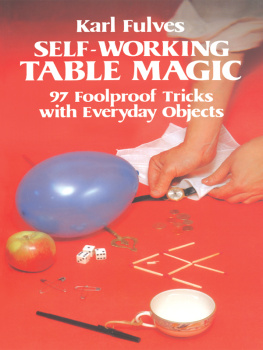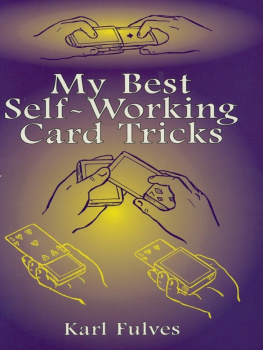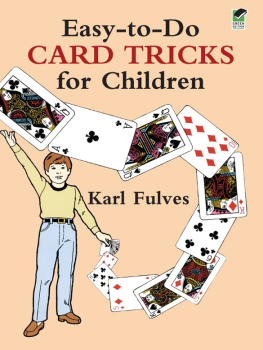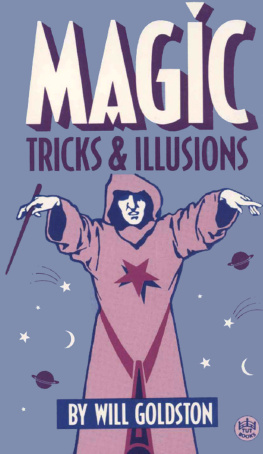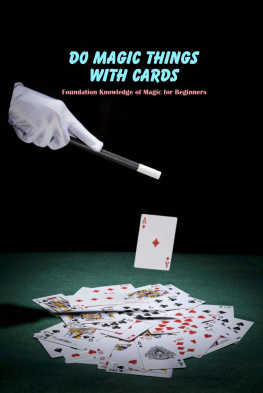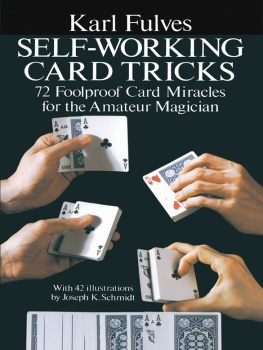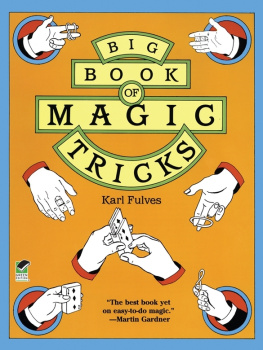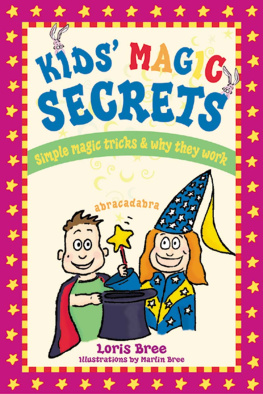SELF-WORKING
TABLE MAGIC
97 FOOLPROOF TRICKS WITH
EVERYDAY OBJECTS
Karl Fulves
With 185 Illustrations by Joseph K. Schmidt
Dover Publications, Inc.
New York
Copyright 1981 by Karl Fulves.
All rights reserved.
Self-Working Table Magic; 97 Foolproof Tricks with Everyday Objects is a new work, first published by Dover Publications, Inc., in 1981.
International Standard Book Number
ISBN-13: 978-0-486-24116-6
ISBN-10: 0-486-24116-5
Manufactured in the United States by Courier Corporation
24116517
www.doverpublications.com
INTRODUCTION
The quickest, most certain path toward achieving a reputation of being a magician is to be able to perform at a moments notice with borrowed objects. If you are handed a coin, a handkerchief, a pencil or a rubber band, you should be able to do at least one amazing trick with that object. This book deals exclusively with just such tricks. It is a collection of some of the best tricks with ordinary objects.
Some chapters have been designed to present the reader with a complete act of close-up magic. For example, the chapter entitled Magic Show in a Matchbox, gives you about 15 minutes worth of excellent tricks and stunts to amaze and amuse your audience. The chapter closes with a jumping match and a match penetration, two of the strongest illusions in close-up magic, and ones that should guarantee you a round of applause from your audiences.
Not considered here are tricks with lit matches, lit cigarettes or knives, on the theory that you shouldnt risk being burned or cut doing magic tricks. But you will find in this book magic with many other objects, from eggs to dice, from cards to balloons, from apples to whisk brooms. There are even tricks done with mirrors.
Magic is the most entertaining hobby because it offers surprise and mystery. When magic is properly presented it will delight and baffle your audiences. Master the tricks in this book and you will be ready to entertain anytime, anywhere, with some of the finest of all close-up mysteries.
A special note of thanks is due Martin Gardner and Joseph K. Schmidt for their assistance in compiling material for this book.
CONTENTS
Everyone carries coins. If you know a few coin tricks, you are always in a position to entertain people with coin magic. The tricks in this chapter represent a collection of some of the best coin routines done without sleights or specially prepared apparatus.
Ask for the loan of a quarter. When you get the coin, remark that some coins of this particular date, unknown to most people, have a low melting point. As a result, the coin has a curious property which you now demonstrate.
The coin is placed under a handkerchief. Immediately the coin melts through the center of the handkerchief. Both the coin and the handkerchief may be borrowed, and the coin may be marked.
METHOD: The trick is accomplished by means of a clever turnover move with the handkerchief. But note that when you borrowed the quarter, you made it seem that the coin was the key element in the trick because it had a low melting point. By making up this story, you focused attention on the coin and therefore away from the handkerchief.
This is the element of misdirection. Audience attention is directed to the object that has very little to do with the working of the trick. In this case the audience will concentrate attention on the coin and forget about the handkerchief. This is all to the good since the coin has nothing to do with the secret working.
Have the spectator note the date on the quarter. You can even have him mark the quarter. When the marked coin is returned to you, hold it between the right thumb and forefinger. Then drape a handkerchief over the right hand. Pinch a bit of the fabric with the right thumb. The situation at this point is shown in .
The left hand grasps the end of the handkerchief that is toward the audience and brings it back onto the right arm, thus exposing the coin to the audiences view, as shown in .
It is here that the trickery comes into play. The left hand releases its grip on the end of the handerchief. The right hand then lowers with a quick snapping motion so that the handkerchief assumes its original position, .
But although this seems to be the original position, with the coin under the handkerchief, the coin is actually outside the handkerchief as indicated in . Thus the trick is over before the audience knows what you are going to do.

F IG . 1.

F IG . 2.

F IG . 3.

F IG . 4.
Twist the handkerchief around the coin a few times with the left hand. Then, while the left hand holds the handerchief, the right hand slowly pulls the coin out into view. It appears as if the coin penetrates the center of the handkerchief. The handkerchief can be returned unharmed to the spectator.
The MacCarthy Hank Fold, described later in this book, allows you to perform the same trick by a different but highly ingenious method.
In this surprising trick you have a spectator hold a penny and a nickel on his outstretched palm. Explain that you will tap either coin with a pencil and that this coin will immediately vanish.
He indicates a coin, say the penny. You tap it with the pencil, but instead of the penny vanishing, the pencil vanishes! The pencil is later found in the pocket.
METHOD: Ask a spectator to remove a penny and another coin from his pocket. Explain that this will work only if one coin is copper and the other silver. Have him place the two coins side by side on his outstretched right palm.
Tell him that he can choose either coin, and that simply by tapping the coin with the pencil, you will cause it to vanish. Thus you will never touch the coin directly, yet the coin will disappear.
Say he indicates the penny. Tap the pencil against the coin and then move the pencil up in an arc as shown in . The coin hasnt vanished, so you tap the coin again. This time bring the right hand further up so it moves past the right side of the face.
Again nothing happens. Tap the coin again. This time bring the right hand up quickly and leave the pencil behind the right ear, .

F IG . 5.

F IG . 6.
Without pause say, One more try. Immediately bring the right hand down as if to tap the coin, but act amazed that the pencil has vanished. If you stand with your left side slightly toward the spectator, or with the face turned slightly to the right, he wont see the pencil behind the ear and thus will be astonished that the pencil has completely vanished.
To produce the pencil magically, direct attention away from yourself. The best way to do this is to point to the floor behind the spectator and say, There it is. As the spectator turns his back to you, remove the pencil from behind the ear and drop it in your pocket.
The spectator cant find the pencil. Act puzzled. Pat your pockets, then pretend to have suddenly discovered the whereabouts of the illusive pencil. Remove it from the pocket. Done smoothly, it is a bewildering sequence.
Next page
